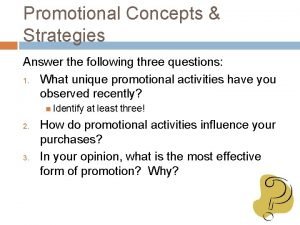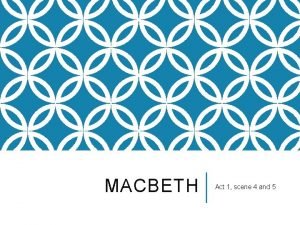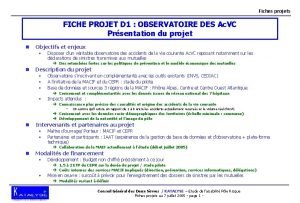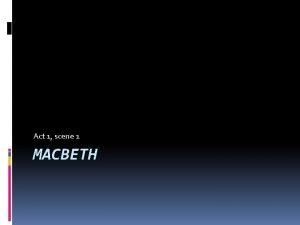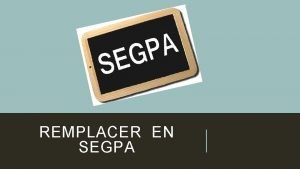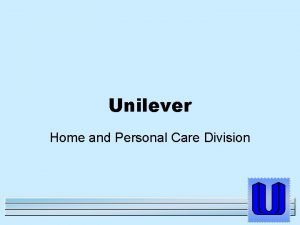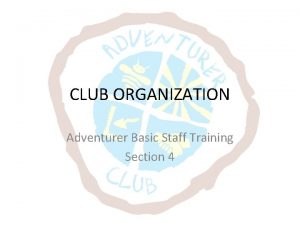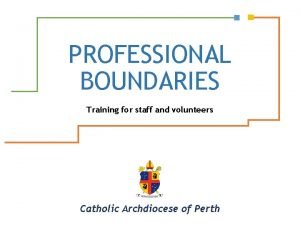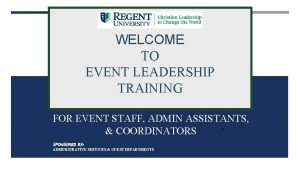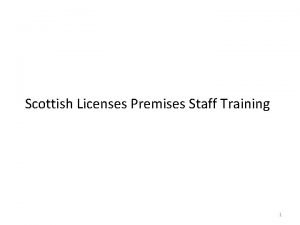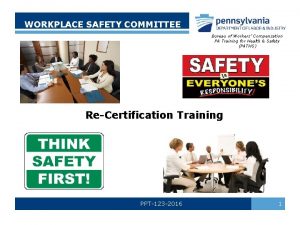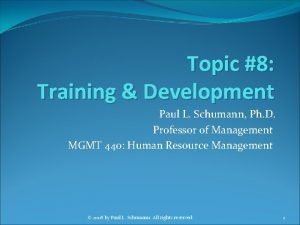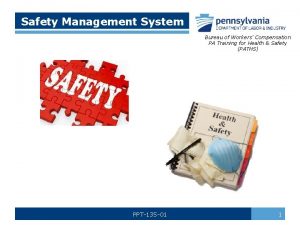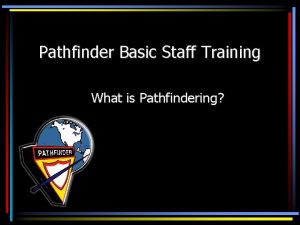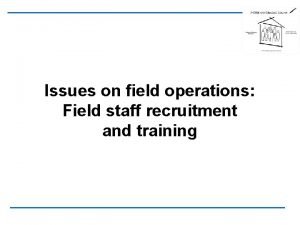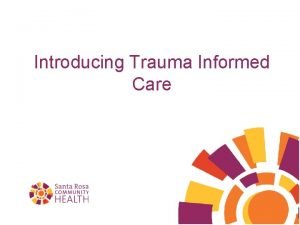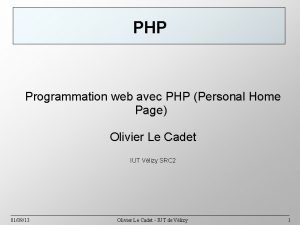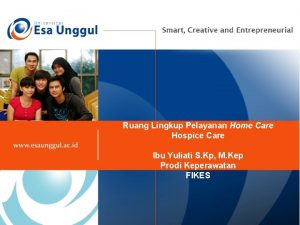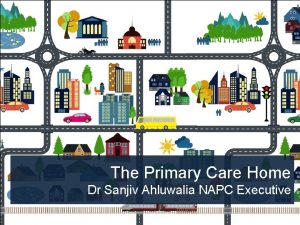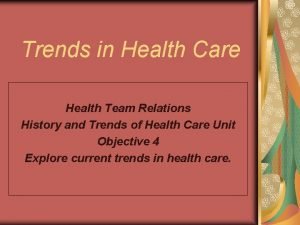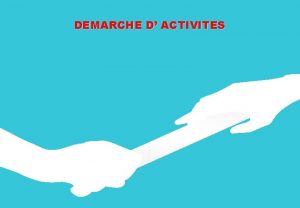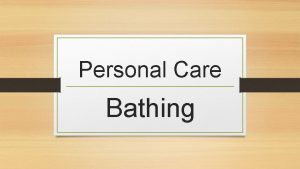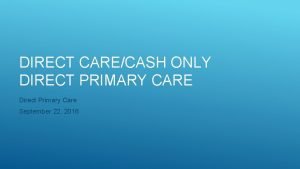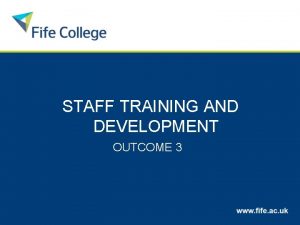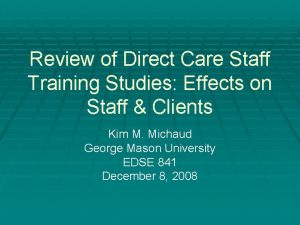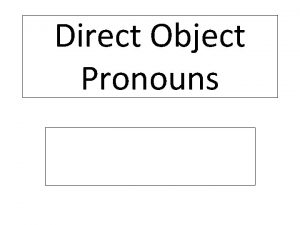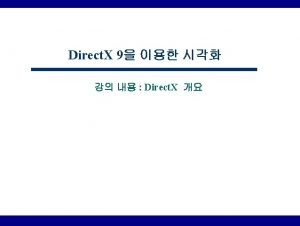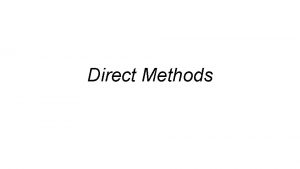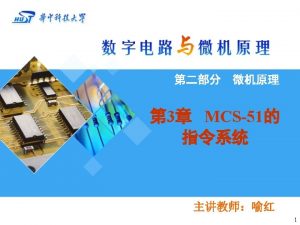PERSONAL CARE HOME DIRECT CARE STAFF TRAINING ACTIVITES













































- Slides: 45

PERSONAL CARE HOME DIRECT CARE STAFF TRAINING ACTIVITES OF DAILY LIVING AND INSTRUMENTAL ACTIVITIES OF DAILY LIVING

INTRODUCTION In this module you will learn about: 1. What serious mental illness (SMI) is; 2. SMI recovery; 3. What ADLs and IADLs are and why they are important; 4. Adult learning principles; 5. Ways that you can help a resident with everyday activities while supporting his or independence and helping the resident keep a sense of self-respect; and 6. 908 KAR 2: 065, and the process for community transition for individuals with SMI.

What is Serious Mental Illness (SMI)? § Serious mental illness is defined as a mental, behavioral, or emotional disorder resulting in serious functional impairment, which substantially interferes with or limits one or more major life activities. § Some serious mental illnesses, such as schizophrenia and schizoaffective disorder, produce delusions, unusual behaviors, distortions of perception, or disorganized thinking. § Other types of SMI, such as bipolar disorder, anxiety disorder and major depression, can impact energy level, ability to concentrate, and sleep patterns.

What does recovery mean for someone living with SMI? § Recovery is a process of change through which individuals improve their health and wellness, live a self-directed life, and strive to reach their full potential. § People with mental illness frequently state that recovery is a journey characterized by a growing sense of independence as well as greater participation in normal daily activities, such as employment, education, and community life. § Recovery can be enhanced by various evidence-based services, such as supported employment, as well as by clinical approaches, such as shared decision-making and peer support.

Key Points to Recovery § Mental health “recovery” refers to the process whereby people with severe mental illness progress to live independent, contributing, and satisfying lives in the community, even with persistent symptoms. § A key goal is to encourage recovery by providing support services to individuals with serious mental illness who are transitioning from institutional settings to communityintegrated programs. § These programs are most successful when provided in preparation to transition (in the PCH) as well as after transition through on-going support services provided out in the community. § Working with residents to help them achieve their goals, including skills necessary for independent living, creates the best atmosphere for success.

Living Independently § Individuals with serious mental illness can live independent and satisfying lives in the community, even with continuing symptoms, and there are services available to help support them. § An individual with SMI may be eligible for state-funded services such as housing assistance, supported employment, and behavioral health services if the resident: 1. Lives in a personal care home; 2. Wants to live in permanent housing in the community; and 3. Is eligible for Medicaid. § 908 KAR 2: 065 provides more information about the transition to independent living and services that are available. § As a direct care provider, you play an important role in helping residents of the personal care home learn and practice important skills necessary for independence. § The purpose of this training is to provide personal care home direct care providers with the skills needed to effectively assist residents with learning those skills whether they want to continue to live in the PCH or transition to independent living.

What are ADLs? This stands for Activities of Daily Living. These are the most basic activities necessary for daily life. They include, but are not limited to, the following: 1. Eating and drinking; 2. Grooming; 3. Dressing; and 4. Bathing or showering.

What are IADLs? This stands for Instrumental Activities of Daily Living. These activities are more complex and include, but are not limited to, activities such as: 1. Shopping; 2. Cooking; 3. Doing laundry; 4. Doing housework; and 5. Managing transportation.

What is the importance of ADLs and IADLs? § ADLs and IADLs represent key life tasks that people need to manage in order to live at home and be fully independent. § Difficulties with performing ADLs and IADLs affect how much help, supervision, and hands-on care a person needs. § The ability to perform ADLs and IADLs can determine when someone is considered “safe” to live independently. § For each ADL or IADL, people can vary from needing just a little help (such as a reminder) to full dependency, which requires others to do the task for them. § Generally, adults need to be able to manage ADLs and IADLs in order to live independently without the assistance of another person. § Even if an individual chooses to reside in a personal care home or other congregate living setting, learning to manage ADLs and IADLs is still important to personal success and happiness.

What causes changes in ADLs and IADLs? § Many things can cause a change in a resident’s ability to perform these basic activities. § Difficulties with ADLs and IADLs can be caused by physical and mental health problems. § People who have lived in an institution, such as a hospital, personal care home, or prison, for an extended period of time may need to learn or relearn certain skills in order to safely transition back into the community.

Three basic things to know about changes in ADLs and IADLs 1. Some residents have been unable to perform some activities for quite some time and have had longer to adjust. 2. Other residents have experienced a recent loss of ability and may still be learning how they can best receive help. 3. Finally, some will be experiencing a temporary loss in their mental or physical abilities from which they will eventually recover.

Why is helping residents with everyday activities so important? § The more ADLs and IADLs a person masters, the more independently they can live. § People who have difficulty performing ADLs and IADLs may feel frustrated, helpless, or vulnerable. § If the residents you serve have these kinds of feelings about everyday activities, you can be sure that the quality of their lives will not be as high as it could be. § This is important because a major part of what you do as a personal care home direct care staff person is aimed at helping people maintain or improve the quality of their lives.

General Helping Rules 1. When you are unsure about preferences or if help is needed, ask. § Sometimes you will observe a resident struggling with a task or you may not be sure of the resident’s needs or preferences. § While your immediate impulse might be to simply start helping, it is better to ask first.

General Helping Rules (continued) 2. Try to use a “person-centered” approach. § A “person-centered” approach involves respecting and honoring the uniqueness of each person and respecting that person’s right to be involved in all decisions that impact his or her life. § These include the little decisions about how ADLs and IADLs are accomplished with your help.

General Helping Rules (continued) 3. If you believe a resident is in immediate danger, then move to help right away. § For example, if a resident has fallen asleep and is about to fall out of a chair, then move to help reposition him/her immediately. § It is not necessary to ask if help is needed in situations where the resident is in danger.

General Helping Rules (continued) 4. When working with an individual always be mindful of cultural diversity. § Avoid imposing your own values. Resist the urge to judge, and make a conscious effort to understand the other perspective. For example, in certain cultures it is acceptable to eat using your hands instead of utensils. § Learn what you can. Talking to members of another culture is a great way to increase your knowledge and overall acceptance. Cultural acceptance is not about changing others to be more like you, it is about exploring and honoring the differences of others.

Examples of Differences in Cultural Norms Mainstream American Culture Other Cultures Dress and Appearance: Wide range of accepted dress. A “dress for success” ideal. Religious rules of dress. Dress often seen as a sign of wealth, prestige, or positions. Food and Eating Habits: Fast food. Eating as necessity. Religious rules for food and eating. Dining is often a social experience. Values and Norms: Individual orientation, independence, and preference for direct confrontation during conflicts. Group orientation, conformity, and preference for harmony.

Adult Learning Principles § Adults need to be involved in the planning and evaluation of their instruction. § Experience (including mistakes) provides the best basis for learning activities. § Adults are most interested in learning subjects that have immediate relevance. § Adult learning should be problem-centered.

Notable Facts and Tips About Adult Learning Theory Adults are internally motivated and self-directed.

Notable Facts and Tips About Adult Learning Theory (continued) Adults bring life experiences and knowledge to learning experiences.

Notable Facts and Tips About Adult Learning Theory (continued) Adults are goal-oriented.

Notable Facts and Tips About Adult Learning Theory (continued) Adults are relevancy oriented.

Notable Facts and Tips About Adult Learning Theory (continued) Adults must have the freedom to learn in their own way.

Notable Facts and Tips About Adult Learning Theory (continued) Adult learning relies on readiness to learn.

Determining How Much Instruction A Resident Needs § Using a person’s functioning level as it relates to Activities of Daily Living (ADLs) and Instrumental Activities of Daily Living (IADLs) can help with determining the level of assistance that person needs. § Residents can use the Self-Assessment worksheet attached to this presentation to evaluate their own ability to perform the ADLs and IADLs listed. § Once a resident has identified the ADLs and/or IADLs for which they need assistance, personal care home staff can provide the resident with additional instruction that is integrated into the normal rhythms of life.

Self-Assessment of ADLs and IADLs • The “Self-Assessment of Activities of Daily Living (ADL)” and “Self-Assessment of Instrumental Activities of Daily Living (IADL)” worksheets provided with this module can be used by residents who desire to transition out of the PCH to indicate the areas in which they feel they need assistance.

Topics to Cover in ADL Instruction At a minimum, topics for ADL instruction should include: § Taking a shower § Personal grooming § Dressing § Eating and drinking § Toileting

Personal Grooming Instruction Grooming your face and skin: 1. Wash your face twice each day. 2. Gently pat your face dry with a clean washcloth. 3. Avoid scrubbing your face dry, which can damage your skin. 4. If you wear make-up, remember to always remove it every night.

Personal Grooming Instruction (continued) Apply moisturizer with sunscreen daily. 1. After cleansing, moisturize your face. 2. Use a moisturizer that contains a minimum of SPF-15 sunscreen to protect your skin from sun damage. 3. Choose a moisturizer that matches your skin type.

Personal Grooming Instruction (continued) Manage your facial hair. 1. When shaving, always use shaving cream to protect and lubricate your face. 2. Use a sharp razor that has no debris lodged between the blades. 3. Always shave in the same direction your facial hair grows.

Personal Grooming Instruction (continued) Brush and style your hair every day. 1. After you get out of the shower, carefully comb through your hair to detangle it. 2. Style your hair as you normally would. 3. Avoid using too much hair product in your hair, which can make it look greasy.

Personal Grooming Instruction (continued) Trim your fingernails regularly. 1. Keep your nails short, neat and clean. 2. Always round the edges. 3. Gently clip hangnails off with nail clippers. 4. If you have long nails, scrub under your fingernails every day using soap, water, and a nail brush or old toothbrush.

Dressing Instruction 1. Allow a realistic amount of time for getting dressed. 2. Choose appropriate clothing for the activities you will be doing that day. 3. Choose appropriate clothing for the weather. 4. Ensure that clothes are not backwards and that shirts with buttons are buttoned correctly. 5. Ensure that zippers are zipped and that belts are worn when needed.

Eating and Drinking 1. Choose a healthy diet that includes fruits and vegetables. 2. Watch your salt intake. 3. Practice moderation. 4. Drink plenty of water. 5. Avoid sugary drinks. 6. Don’t skip breakfast. 7. Eat three meals a day with healthy snacks in between meals.

Topics to Cover in IADL Instruction At a minimum, topics should include: § Shopping § Cooking § Doing housework § Doing laundry § Managing transportation

Shopping § Many residents have not been responsible for their own shopping in quite some time. § One way a resident could practice this skill would be to have the resident write out a shopping list for a specific meal or dish.

Meal Planning and Preparation § Meal prepping is a practice designed to make meals one day per week that will last for the rest of the week. § It is a great way to save time and money, and to ensure a healthy diet each week.

Microwave Cooking § Cooking with a microwave oven is highly convenient, simple, and incredibly fast. § Food cooked in a microwave oven is as safe, and has the same nutrient value, as food cooked in a conventional oven.

How to Clean Your House or Apartment Quickly and Effectively § When providing instruction to a resident on how to clean his or her room, house, or apartment, provide simple step-by-step instructions as you lead the resident through the process. § He or she can practice the steps by cleaning their room in preparation for their transition to their own house or apartment.

Managing Transportation: Asking someone for a ride § Many residents aren’t able to drive, or are able to drive but do not own a car. § While there are plenty of alternate ways of getting around, such as walking, biking, or taking a bus, these methods aren’t always available or convenient.

Managing Transportation: Use of public transportation § While learning how to ride the bus to get from point A to point B may seem overwhelming, it’s usually relatively simple. § After taking a couple of trips on the bus, the resident will be riding like a pro. § Many residents return to a PCH because they lack a means of transportation to get them to places they need to go, such as a doctor’s office, the grocery store, or to visit friends and family.

Communicating with Others § At times, residents may find it difficult to convey their needs to family, friends, work colleagues, staff, and others. § Teaching residents how to effectively communicate with others to get their needs met will enhance their life satisfaction.

Transition Process – 908 KAR 2: 065 § If a resident with SMI wants to transition to independent living, he or she must be evaluated by a qualified mental health provider to determine whether: 1. He or she is eligible to transition; and 2. The transition would be clinically appropriate.

How You Can Help § If a resident with SMI wants to move out of the personal care home and live independently, you can help the resident request evaluation and services by: 1. 2. 3. Calling 1 -800 -374 -9146; Using wwww. dbhdid. ky. gov/ISA; or Talking to the in-reach worker who visits the personal care home where you work. § After the resident submits a request, share information with the in-reach worker, targeted case manager, Assertive Community Treatment (ACT) team members, or other behavioral health professionals who visit the resident to assist with transition. § Provide support for the resident and instruction as coordinated by the behavioral health staff as the resident works to transition and learn new skills. § You can help them succeed!

Conclusion § Difficulty performing ADLs and IADLs can cause serious problems for patients with SMI who want to live in the community. § Assisting clients with learning skills for self-care activities can improve quality of life for residents, reduce stress and anxiety, and decrease risk of re-entry to a personal care home. § Individuals with SMI generally want to live independently, be in society with dignity, have a job with self-esteem, have a partner for love and affection, have a home for safety, hope for a future, and have all civil rights like everyone else. § By learning these important skills, residents will have a better quality of life and a brighter future.
 Apa arti home care
Apa arti home care Perbedaan home care dan home visit
Perbedaan home care dan home visit Promotional activites
Promotional activites Non personal promotion
Non personal promotion Act 1 scene 4 macbeth modern english
Act 1 scene 4 macbeth modern english Activités professionnelles
Activités professionnelles Fiches projets
Fiches projets Slide todoc.com
Slide todoc.com Macbeth act 1 scene 1 script
Macbeth act 1 scene 1 script Je lis, je comprends segpa
Je lis, je comprends segpa Activités occupationnelles en psychiatrie
Activités occupationnelles en psychiatrie Uia caen activités
Uia caen activités 5 activités langagières
5 activités langagières Décloisonnement des activités
Décloisonnement des activités Unilever home care
Unilever home care Booth staff training
Booth staff training Adventurer basic staff training
Adventurer basic staff training Boundaries training for staff
Boundaries training for staff Event staff training
Event staff training Licensed premises staff training
Licensed premises staff training Pa safety committee
Pa safety committee Needs analysis example
Needs analysis example Safety training for housekeeping staff ppt
Safety training for housekeeping staff ppt What is pathfindering
What is pathfindering Field staff training
Field staff training Mobile home parks for sale in sc
Mobile home parks for sale in sc Plurals of flower
Plurals of flower Softly and tenderly jesus is calling
Softly and tenderly jesus is calling New mobile home sales oak springs mobile home community
New mobile home sales oak springs mobile home community What did you say
What did you say André fougeron
André fougeron She said that, home economics stands for the ideal home.
She said that, home economics stands for the ideal home. Home sweet home: survive
Home sweet home: survive Trauma informed icebreakers
Trauma informed icebreakers Levels of health care primary secondary tertiary
Levels of health care primary secondary tertiary Home php
Home php Personal home page php
Personal home page php Ruang lingkup home care
Ruang lingkup home care Ohio home care waiver
Ohio home care waiver Mekanisme pelayanan home care
Mekanisme pelayanan home care Hbyc training module in marathi
Hbyc training module in marathi Arti home care
Arti home care Veterans directed home and community based care
Veterans directed home and community based care Napc primary care home
Napc primary care home Ohiohcbs.pcgus.com
Ohiohcbs.pcgus.com Home health care definition
Home health care definition



